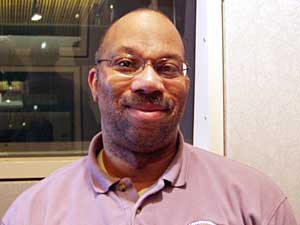|
Audio
Photos
More from MPR
|
February 17, 2005
 |
| Jerry Blakey's grandfather, Casiville Bullard, was a skilled craftsman who helped build the state Capitol. (MPR Photo/Toni Randolph) |
St. Paul, Minn. — Jerry Blakey's grandfather, Casiville Bullard, helped build the Capitol -- a contribution that was noted in the official program marking the centennial, an honor that made Blakey proud.
"It made me feel good that there were people in my family who had the skills and talent, and were finally getting recognized," he said.
Blakey's grandfather was one of the many black skilled craftsmen who worked on the building designed by architect Cass Gilbert. Some of them came to St. Paul along with the Georgia marble that Gilbert insisted be used.
Others, like Blakey's grandfather, were recruited for the project. Casiville Bullard moved to St. Paul from Memphis. Blakey never knew his grandfather -- he was just a baby when Bullard died -- but he'd heard stories about him all his life from his mother.
"As we drove around St. Paul and other places, she would always talk about, 'Your grandfather worked on this building, your grandfather worked on that.' And as a kid it didn't really have the significance," Blakey said. "It wasn't until I got in my mid-20s that it started to hit me that here we are in the state Capitol, and how important that building is."
African-Americans made up less than 1 percent of Minnesota's population at the turn of the 20th century. And many of the black people who lived here then worked in service jobs.
But the construction of the State Capitol brought a population of black stone masons, stonecutters, bricklayers and other skilled craftsmen like Casiville Bullard to St. Paul. Historian Laura Weber, who researched Bullard's life, says people need to know that.
"When you hear about American history of blacks, St. Paul doesn't figure in that much. But that's partly why it's important," said Weber. "Because it's important to know this man lived in our midst, and contributed to the greater good and to the public realm."
Former state law librarian Marvin Anderson agrees. His grandfather, Ernest Jones, was recruited from Chicago to work on the state Capitol, as a mason. Anderson says Black History Month offers an opportunity to learn more about people like his grandfather.
"The role of the African-American tradesman in any endeavor has been depreciated over the years," said Anderson. "I think it's good during this time of the month that the achievements and the contributions that African American men and women have made to our communities, and to the nation and world, get adequate notice, because for so many years it just hasn't been taught."
Anderson and his 94-year-old mother also attended the state Capitol's centennial celebration last month. He said he was beaming with pride at the honor both his mother and his grandfather received.
"I was so pleased she had an opportunity to be recognized for the work her father did on the state Capitol, and we're a part of it now," Anderson said.
Many black tradesman worked on the state Capitol, but only a few of their names are known. Most of them, like Anderson's grandfather, returned to their homes after their work was done. But a few, like Casiville Bullard, stayed in St. Paul.
In fact, the brick home Bullard built on Folsom Street is on the National Register of Historic Places, recognized because of his work on the Minnesota State Capitol and other St. Paul landmarks.






